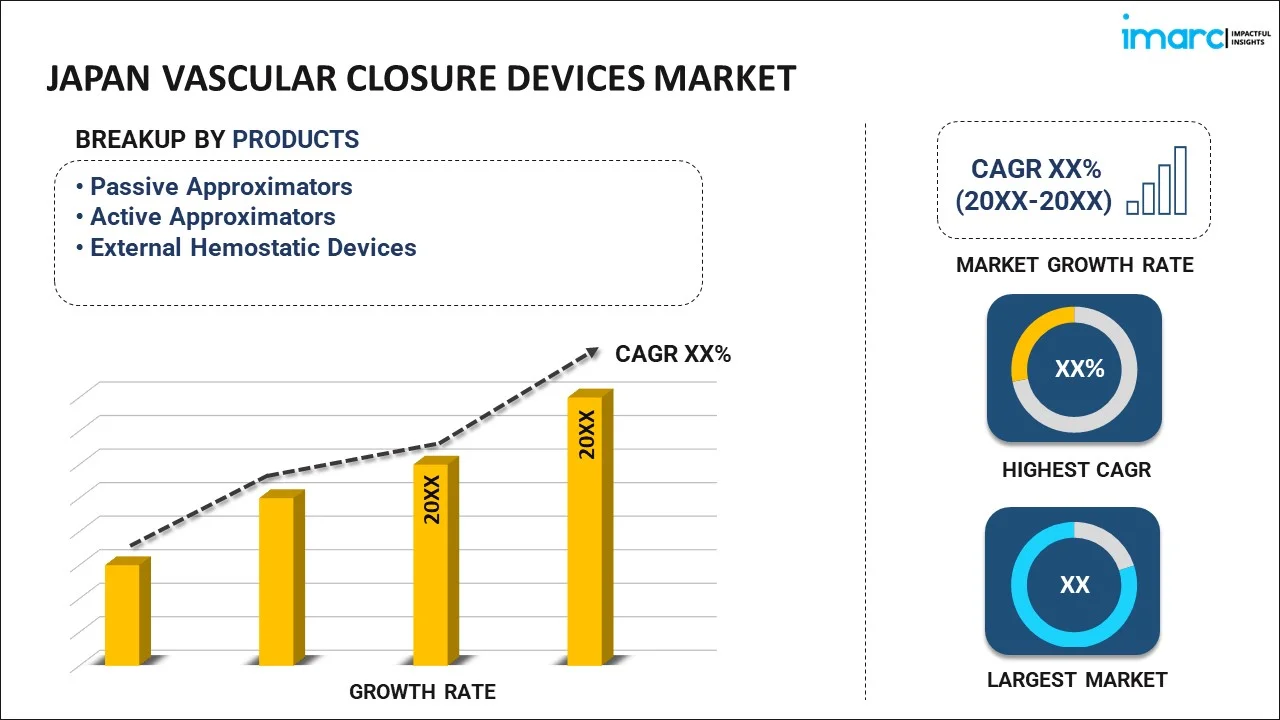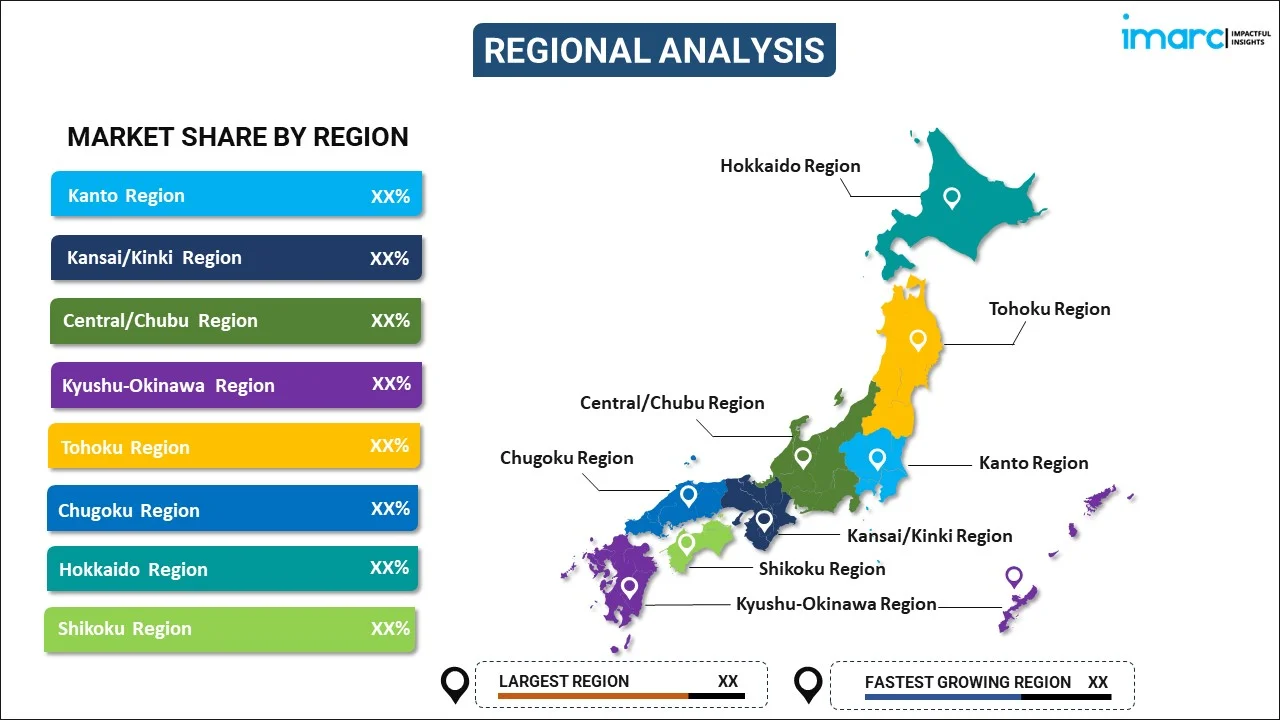
Japan Vascular Closure Devices Market Report by Product (Passive Approximators, Active Approximators, External Hemostatic Devices), Access Type (Femoral Access, Radial Access), Procedure (Interventional Cardiology, Interventional Radiology/Vascular Surgery), End User (Hospitals, Ambulatory Surgical Centers, and Others), and Region 2025-2033
Market Overview:
Japan vascular closure devices market size reached USD 92.0 Million in 2024. Looking forward, IMARC Group expects the market to reach USD 161.0 Million by 2033, exhibiting a growth rate (CAGR) of 6.4% during 2025-2033. The growing healthcare sector, elevated occurrence of cardiovascular disorders, and a rising need for efficient blood loss management in patients are among the primary factors propelling the market growth.
|
Report Attribute
|
Key Statistics
|
|---|---|
|
Base Year
|
2024
|
|
Forecast Years
|
2025-2033
|
|
Historical Years
|
2019-2024
|
|
Market Size in 2024
|
USD 92.0 Million |
|
Market Forecast in 2033
|
USD 161.0 Million |
| Market Growth Rate 2025-2033 | 6.4% |
Vascular closure devices (VCDs) are employed in medical facilities worldwide, including hospitals, clinics, specialty centers, and ambulatory surgery centers. They serve the crucial purpose of promptly sealing the small puncture created in an artery following an angiogram procedure. These devices find extensive usage, particularly among patients undergoing catheterization through the femoral route, in comparison to traditional mechanical compression methods. Additionally, they are beneficial in scenarios involving patients with a larger body build and those undergoing anticoagulation and antiplatelet therapies. These devices aid in reducing the time required for achieving hemostasis, enabling patients to mobilize more quickly, alleviating patient discomfort associated with prolonged bed rest, shortening hospital stays, and preventing complications related to the femoral artery. Consequently, there is an increasing demand for VCDs in the healthcare industry.
Japan Vascular Closure Devices Market Trends:
The expanding healthcare sector constitutes a significant driving force behind market growth in Japan. Additionally, there is a growing demand for catheterization and interventional procedures to diagnose and treat CVDs, creating attractive growth prospects for industry stakeholders. Moreover, the surging need for advanced surgical equipment in hospitals and surgical centers is exerting a positive impact on the market. Furthermore, the preference for femoral access in vascular procedures during coronary angiography and other interventions is on the rise globally. This preference, coupled with an increasing demand for non-invasive procedures to minimize sutures and scarring, is contributing positively to market growth. Furthermore, healthcare professionals are placing a greater emphasis on effective blood loss management in patients undergoing surgical procedures, further strengthening market expansion. Additionally, key manufacturers within the industry are concentrating on the production of large-bore vascular closure devices. This aligns with the growing number of registrations for innovative devices by prominent market players, which is accelerating market growth. Furthermore, there is increasing awareness among the general public regarding the advantages of VCDs, including facilitating minimally invasive procedures, achieving favorable patient outcomes, enabling early ambulation, and enhancing comfort during medical interventions. This heightened awareness is expected to catalyze the market growth over the forecasted period.
Japan Vascular Closure Devices Market Segmentation:
IMARC Group provides an analysis of the key trends in each segment of the market, along with forecasts at the country level for 2025-2033. Our report has categorized the market based on product, access type, procedure, and end user.
Product Insights:

- Passive Approximators
- Collagen Plugs
- Sealant or Gel-Based Devices
- Compression-Assist Devices
- Active Approximators
- Suture-Based Devices
- Clip-Based Devices
- External Hemostatic Devices
The report has provided a detailed breakup and analysis of the market based on the product. This includes passive approximators (collagen plugs, sealant or gel-based devices, and compression-assist devices), active approximators (suture-based devices and clip-based devices), and external hemostatic devices.
Access Type Insights:
- Femoral Access
- Radial Access
A detailed breakup and analysis of the market based on the access type have also been provided in the report. This includes femoral access and radial access.
Procedure Insights:
- Interventional Cardiology
- Interventional Radiology/Vascular Surgery
The report has provided a detailed breakup and analysis of the market based on the procedure. This includes interventional cardiology and interventional radiology/vascular surgery.
End User Insights:
- Hospitals
- Ambulatory Surgical Centers
- Others
A detailed breakup and analysis of the market based on the end user have also been provided in the report. This includes hospitals, ambulatory surgical centers, and others.
Regional Insights:

- Kanto Region
- Kansai/Kinki Region
- Central/ Chubu Region
- Kyushu-Okinawa Region
- Tohoku Region
- Chugoku Region
- Hokkaido Region
- Shikoku Region
The report has also provided a comprehensive analysis of all the major regional markets, which include Kanto Region, Kansai/Kinki Region, Central/ Chubu Region, Kyushu-Okinawa Region, Tohoku Region, Chugoku Region, Hokkaido Region, and Shikoku Region.
Competitive Landscape:
The market research report has also provided a comprehensive analysis of the competitive landscape. Competitive analysis such as market structure, key player positioning, top winning strategies, competitive dashboard, and company evaluation quadrant has been covered in the report. Also, detailed profiles of all major companies have been provided.
Japan Vascular Closure Devices Market Report Coverage:
| Report Features | Details |
|---|---|
| Base Year of the Analysis | 2024 |
| Historical Period | 2019-2024 |
| Forecast Period | 2025-2033 |
| Units | Million USD |
| Scope of the Report | Exploration of Historical Trends and Market Outlook, Industry Catalysts and Challenges, Segment-Wise Historical and Future Market Assessment:
|
| Products Covered |
|
| Access Types Covered | Femoral Access, Radial Access |
| Procedures Covered | Interventional Cardiology, Interventional Radiology/Vascular Surgery |
| End Users Covered | Hospitals, Ambulatory Surgical Centers, Others |
| Regions Covered | Kanto Region, Kansai/Kinki Region, Central/ Chubu Region, Kyushu-Okinawa Region, Tohoku Region, Chugoku Region, Hokkaido Region, Shikoku Region |
| Customization Scope | 10% Free Customization |
| Post-Sale Analyst Support | 10-12 Weeks |
| Delivery Format | PDF and Excel through Email (We can also provide the editable version of the report in PPT/Word format on special request) |
Key Questions Answered in This Report:
- How has the Japan vascular closure devices market performed so far and how will it perform in the coming years?
- What has been the impact of COVID-19 on the Japan vascular closure devices market?
- What is the breakup of the Japan vascular closure devices market on the basis of product?
- What is the breakup of the Japan vascular closure devices market on the basis of access type?
- What is the breakup of the Japan vascular closure devices market on the basis of procedure?
- What is the breakup of the Japan vascular closure devices market on the basis of end user?
- What are the various stages in the value chain of the Japan vascular closure devices market?
- What are the key driving factors and challenges in the Japan vascular closure devices?
- What is the structure of the Japan vascular closure devices market and who are the key players?
- What is the degree of competition in the Japan vascular closure devices market?
Key Benefits for Stakeholders:
- IMARC’s industry report offers a comprehensive quantitative analysis of various market segments, historical and current market trends, market forecasts, and dynamics of the Japan vascular closure devices market from 2019-2033.
- The research report provides the latest information on the market drivers, challenges, and opportunities in the Japan vascular closure devices market.
- Porter's five forces analysis assist stakeholders in assessing the impact of new entrants, competitive rivalry, supplier power, buyer power, and the threat of substitution. It helps stakeholders to analyze the level of competition within the Japan vascular closure devices industry and its attractiveness.
- Competitive landscape allows stakeholders to understand their competitive environment and provides an insight into the current positions of key players in the market.
Need more help?
- Speak to our experienced analysts for insights on the current market scenarios.
- Include additional segments and countries to customize the report as per your requirement.
- Gain an unparalleled competitive advantage in your domain by understanding how to utilize the report and positively impacting your operations and revenue.
- For further assistance, please connect with our analysts.
 Request Customization
Request Customization
 Speak to an Analyst
Speak to an Analyst
 Request Brochure
Request Brochure
 Inquire Before Buying
Inquire Before Buying




.webp)




.webp)












